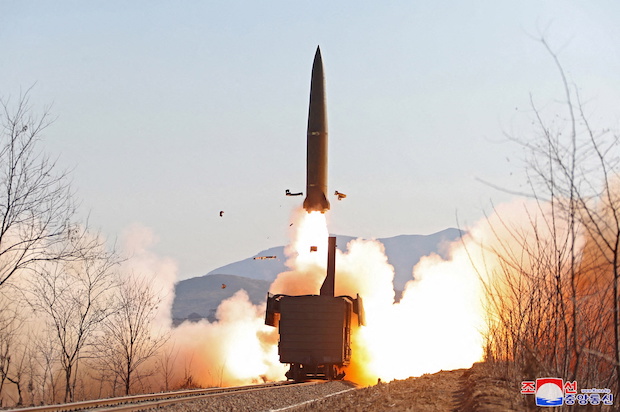North Korea tests railway-borne missile in latest launch amid rising tension with US

A railway-born missile is launched during firing drills according to state media, at an undisclosed location in North Korea, in this photo released Jan. 14, 2022, by North Korea’s Korean Central News Agency (KCNA). (KCNA via REUTERS )
SEOUL — North Korea tested a railway-borne missile in its firing drills on Friday, state media KCNA said on Saturday, amid a US push for fresh sanctions against the isolated state following its recent series of weapons tests.
South Korea’s Joint Chiefs of Staff said two short-range ballistic missiles (SRBMs) traveled about 430 km (267 miles) to a maximum altitude of 36 km (22 miles) after being launched eastward on the northwest coast of North Korea.
The official KCNA news agency did not specify the missiles’ range, or trajectory, but said a firing drill was held in North Pyongan Province to “check and judge the proficiency in the action procedures of the railway-borne regiment.”
The country tested the rail-based system for the first time last September, saying it was designed as a potential counter-strike to any threatening forces.
Since New Year’s Day, North Korea has launched three ballistic missiles in an unusually fast sequence of weapons tests. The previous two launches involved what state media called “hypersonic missiles” capable of high speeds and maneuvering after launch.
Article continues after this advertisementHours before the latest test drill, North Korea slammed the United States for pursuing new sanctions in response to its recent missile launches, calling it a “provocation” and warning of a strong reaction.
Article continues after this advertisementUS President Joe Biden’s administration imposed its first sanctions against Pyongyang on Wednesday and called on the UN Security Council to blacklist several North Korean individuals and entities.
North Korea has defended the missile tests as its sovereign right to self-defense and accused the United States of intentionally escalating the situation with new sanctions.
North Korean leader Kim Jong Un did not attend the drill. KCNA said the military leadership had ordered the test “at short notice” and the system precisely struck the target set on the east coast with “two tactical guided missiles.”
The system “demonstrated high maneuverability and rate of hits,” KCNA said, adding its success led to discussions to “set up proper railway-borne missile operating system across the country.”
North Korea has been steadily developing its weapons systems, raising the stakes for stalled talks aimed at dismantling its nuclear and ballistic missile arsenals in return for US sanctions relief.
South Korean Chung Eui-yong and US Secretary of State Antony Blinken condemned the latest launch during their phone call on Saturday and coordinated responses to the North’s recent missile tests, the State Department said.
Both sides highlighted the importance of maintaining a firm combined readiness posture and urged Pyongyang to return to a negotiating table, Seoul’s foreign ministry said.
‘At short notice‘
Cheong Seong-chang, director for North Korean studies at South Korea’s Sejong Institute, said the test could be an “instant display of force” to protest against the US sanctions push, noting that it was not planned in advance and unusually took place in the afternoon.
“It’s a message that they would take an ‘eye to eye’ approach if Washington presses for sanctions for testing non-long-range missiles,” Cheong said.
KCNA released photographs showing a missile trailing a column of smoke and flame as it was launched from the top of an olive-green train in a mountainous area, before arrowing down on a small island, sending up a cloud of smoke and debris as it hit.
Despite North Korea’s limited and sometimes unreliable rail network, rail-mobile missiles are a relatively cheap and efficient option to improve the survivability of their nuclear forces, making it difficult for enemies to detect and destroy them before being fired, analysts said.
Kim Dong-yup, a former South Korea Navy officer who teaches at Seoul’s Kyungnam University, said North Korea appears to have fired KN-23 SRBMs, which were also test-fired in September when they flew 800 km (497 miles).
First tested in May 2019, the KN-23 resembles Russia’s Iskander-M SRBM visually, and is designed to evade missile defenses and conduct precision strikes, experts said.